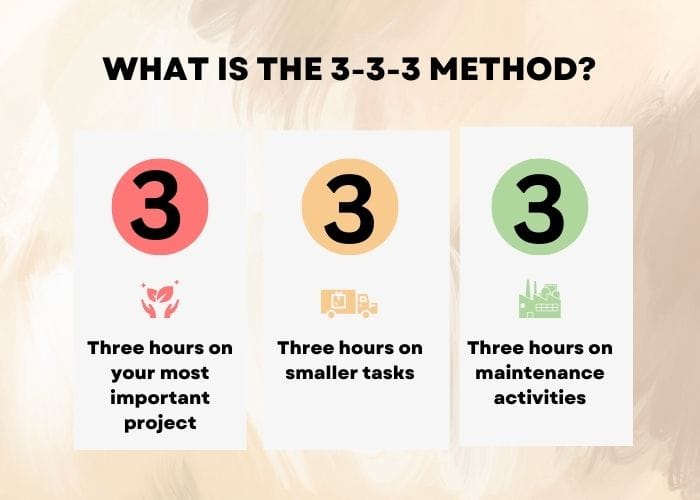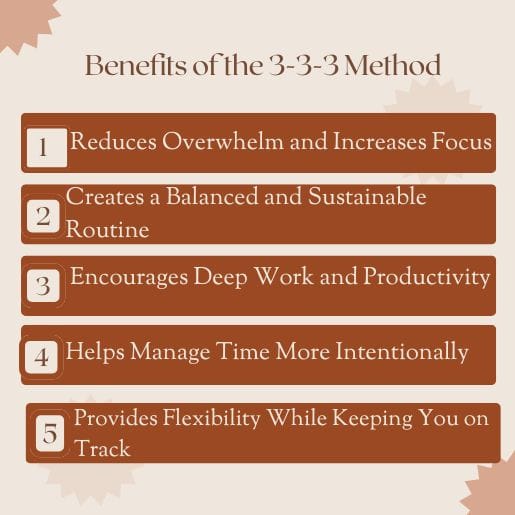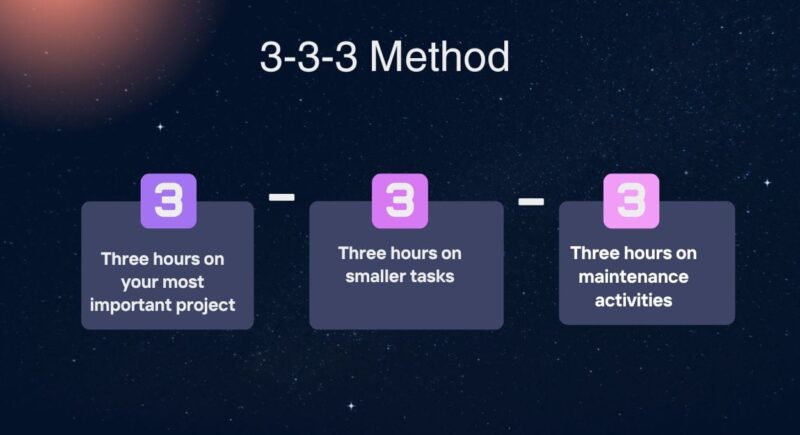Time is one of the most valuable assets we have, yet most of us struggle to manage it effectively. Between work, personal life, and endless distractions, it often feels like there just aren’t enough hours in the day. That’s where the 3-3-3 Method comes in—a structured approach to productivity that helps you prioritize tasks, maintain focus, and achieve balance in your daily routine.
Developed by Oliver Burkeman, the author of Four Thousand Weeks: Time Management for Mortals, this method is gaining attention for its practicality and efficiency. It’s not about squeezing in more work but about using your time intentionally so you can stay productive without feeling overwhelmed. Let’s break it down and see how it can transform the way you manage your time.
What is the 3-3-3 Method?

At its core, the 3-3-3 Method divides your workday into three key segments:
- Three hours on your most important project – This is where you focus on the one task that truly moves the needle. Whether it’s a business goal, creative work, or a big assignment, dedicating three uninterrupted hours ensures deep, meaningful progress.
- Three hours on smaller tasks – This includes secondary responsibilities, emails, planning, or meetings that support your main goals. Instead of letting them take over your entire day, you allocate just enough time to keep them in check.
- Three hours on maintenance activities – These are essential but non-work-related tasks such as exercise, household chores, self-care, or learning. By dedicating time to these areas, you create a well-rounded routine that prevents burnout.
The remaining time in your day can be used flexibly, whether for relaxation, socializing, or additional tasks if needed. The beauty of the 3-3-3 Method is that it brings clarity to your schedule, making sure your efforts align with your priorities.
Benefits of the 3-3-3 Method

1. Reduces Overwhelm and Increases Focus
When too many tasks compete for attention, it can lead to stress, confusion, and inefficiency. The 3-3-3 Method eliminates this scattered approach by prioritizing one major project at a time. Instead of switching between tasks and struggling with constant interruptions, this method helps you direct your energy toward meaningful work. By dedicating three uninterrupted hours to your most important project, you allow yourself to dive deeper into problem-solving, creative thinking, and strategic execution. This focused approach not only reduces stress but also enhances clarity, ensuring that every effort you put in brings maximum results.
2. Creates a Balanced and Sustainable Routine
A workday that is solely consumed by deadlines and responsibilities can quickly lead to burnout, frustration, and lack of motivation. Many people struggle to maintain a work-life balance, often sacrificing personal time for the sake of productivity. The 3-3-3 Method prevents this by ensuring that your time is divided between high-priority tasks, smaller responsibilities, and essential maintenance activities like self-care and exercise. This structured approach promotes a healthy, sustainable lifestyle, preventing exhaustion and making it easier to stay motivated in the long run. Rather than feeling drained at the end of the day, you’ll find yourself more energized, focused, and in control of your time.
3. Encourages Deep Work and Productivity
Distractions are one of the biggest barriers to productivity. Whether it’s emails, social media, or unnecessary meetings, constant interruptions make it difficult to get into a deep work state—a mental mode where you can fully concentrate and perform at your best. The first three-hour block of the 3-3-3 Method is specifically designed to eliminate distractions and help you engage in uninterrupted, high-impact work. This approach aligns with research showing that deep work leads to higher efficiency, better problem-solving skills, and improved creativity. By focusing intensely on one significant task, you accomplish more in less time, producing higher-quality results while minimizing fatigue.
4. Helps Manage Time More Intentionally
A common mistake in time management is spending the entire day reacting to emails, meetings, and random tasks instead of proactively working on priorities. The 3-3-3 Method shifts your focus from a reactive mindset to an intentional one. By setting clear blocks of time for different types of work, it becomes easier to avoid time-wasting activities and stay committed to tasks that align with long-term goals. Instead of feeling like time is slipping away, you take charge of your schedule with a structured yet flexible approach. This leads to better decision-making, improved task execution, and a more disciplined work ethic that enhances overall efficiency.
5. Provides Flexibility While Keeping You on Track
Many productivity methods are rigid, making it difficult to adjust when unexpected situations arise. The 3-3-3 Method, however, offers a structured yet adaptable framework that works for different schedules and workloads. If a certain day requires more time for meetings or unexpected tasks, you can adjust the three-hour blocks without losing track of your priorities. This flexibility ensures that while your routine remains structured, it doesn’t become restrictive. The balance between focus and adaptability makes this method realistic and easy to sustain, helping you stay organized while still accommodating the demands of daily life.
Take Charge of Your Time
Time management doesn’t have to be complicated. The 3-3-3 Method offers a simple yet powerful way to structure your day, helping you focus on what truly matters while maintaining balance in other areas of life.
Now it’s your turn. Try following this method for a week and observe how it enhances your productivity. What is the biggest obstacle you face in effectively managing your time? Share your thoughts in the comments below, and don’t forget to pass this along to someone who might find it helpful!

